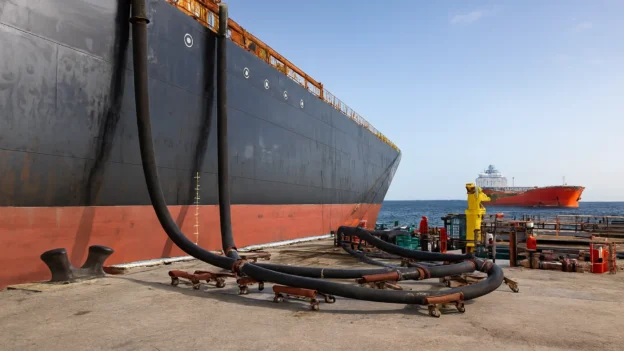Table of Contents
- Service life of marine hoses
- Summary Table Service Life Criteria
- Factors that reduce marine hose durability
- Effective practices to extend service life and durability
- Summary Table – Recommended Actions
- Conclusion
- References
Did you know that a single failure in a marine hose can halt an entire fuel transfer operation, creating environmental risks and causing million-dollar losses? Extreme marine conditions, chemical exposure, and physical wear significantly reduce their service life and durability. Implementing a preventive maintenance approach, regular hose inspections, and good operational practices ensures safety, efficiency, and longer service life.
This article outlines proven strategies, international standards (OCIMF), and technical recommendations to optimize the durability and performance of marine hoses in professional operations.
Service life of marine hoses
The service life of marine hoses is not defined by a fixed universal value but estimated from a combination of technical, operational, and environmental factors, supported by international standards such as the OCIMF (Oil Companies International Marine Forum).
While the OCIMF does not establish a mandatory lifespan, it recommends that hoses be removed and subjected to a full hose inspection after five years. This period represents the initial operational life. Manufacturers such as Yokohama Seaflex, Trelleborg, and Dunlop design hoses with a structural life of up to ten years, provided that service conditions are normal and periodic inspections confirm their integrity.
In other words, the service life of marine hoses depends not only on their design or materials but on the technical discipline applied in maintenance, hose inspection, and daily operation. Implementing preventive practices, following OCIMF recommendations, and performing regular revalidations help extend hose service safely. A proactive management strategy ensures system reliability, reduces environmental risk, and guarantees operational continuity during marine fuel transfer operations.
Summary Table Service Life Criteria
| Stage | Action | Justification |
| Up to 5 years | Normal operation | Within recommended operational life |
| 5–10 years | Major inspection + annual revalidation | Structural condition control |
| >10 years | Restricted use only if all tests are passed | Under operator’s responsibility; no manufacturer warranty |
| >12 years | Final withdrawal | High risk of internal degradation (reinforcement fatigue, rubber aging) |
Factors that reduce marine hose durability
The durability of marine hoses can be compromised by multiple factors. Identifying them is essential to implementing effective preventive maintenance strategies.
Operation beyond design specifications
Operating hoses outside their rated pressure, temperature, or product compatibility drastically reduces service life. Manufacturers specify clear limits; ignoring them accelerates deterioration.
Adverse environmental conditions
Marine hoses are exposed to salinity, UV radiation, humidity, and thermal variations. These factors cause cracking, material embrittlement, and loss of flexibility.
Chemical exposure
During fuel transfer, hoses may come into contact with incompatible chemicals, degrading the internal lining and compromising operational safety.
Physical wear
Dragging, frequent coiling, or contact with rough surfaces lead to abrasion and structural damage. This mechanical wear directly affects marine hose durability.
Incorrect installation
Improper installation induces unnecessary stress that may deform or rupture the hose. Correct arrangement of couplings and guides is essential for maintaining integrity.
Improper storage
Extreme temperature, humidity, ozone, sunlight, insects, or rodents reduce the service life of marine hoses during storage. Hoses should be protected and periodically rotated to prevent deformation.
Effective practices to extend service life and durability
To maximize marine hose durability and extend their service life, an integrated approach is recommended based on proper selection, installation, preventive maintenance, and regular hose inspection.
Proper hose selection
- Verify chemical compatibility with the products to be transferred.
- Ensure adequate pressure and temperature ratings for operational conditions.
- Evaluate abrasion and torsion resistance, flexibility, and appropriate diameter and length.
- Prefer hoses certified under OCIMF and ISO standards.
- Consider long-term durability based on operational cycles and environmental conditions.
Correct installation
- Use certified couplings and flanges.
- Avoid twisting, over-bending, or unnecessary tension.
- Install guides or additional supports to prevent wear.
- Follow manufacturer safety protocols and recommendations.
Preventive maintenance
Preventive maintenance of marine hoses significantly extends service life and reduces failures by applying the following practices:
Periodic visual inspection
- Before and after each use.
- Detect cracks, wear, leaks, or coupling damage.
Pressure testing
- Perform hydrostatic tests annually or as recommended by the manufacturer.
- Ensures the hose withstands operational pressure without failure.
Electrical and elongation tests
- Detect internal weaknesses and compromised reinforcements.
Inspection schedule summary
| Type of Inspection | Frequency | Purpose |
| External visual | Each operation | Detect cracks, wear, coupling damage |
| Hydrostatic test | Annual | Verify resistance to working pressure |
| Electrical and elongation test | Annual or per regulations | Detect internal weakness; avoid static buildup in conductive hoses |
| Internal inspection | Every 2–3 years | Detect internal degradation or corrosion |
Cleaning and drying
- Remove fuel or chemical residues.
- Complete drying prevents mold and material degradation.
Timely component replacement
- Replace worn couplings, seals, and gaskets to maintain system integrity.
Good operational practices
- Do not drag marine hoses on abrasive surfaces.
- Maintain minimum bend radius and operate within rated pressure and temperature limits.
- Use wide slings and protectors during lifting.
- Continuously monitor for leaks, swelling, or deformation.
Transport and storage
- Transport hoses on padded reels or supports.
- Store in cool, dry, and ventilated areas, protected from UV, ozone, and chemicals.
- Rotate periodically to avoid permanent deformation.
Standards and guidelines
- Follow OCIMF guidelines for handling, storage, use, testing, and maintenance.
- Apply ISO 18262 and other applicable certifications.
Personnel training
- Train operators on operational limits and hose inspection practices.
- Proper training reduces accidental damage and improves incident response.
Advanced inspection and record keeping
- Maintain a digital record for each hose, including inspections, tests, maintenance, and replacements.
- Facilitates audits, service life tracking, and replacement planning.
- Include periodic internal inspections and functional testing of critical components.
Summary Table – Recommended Actions
| Area | Recommended Action |
| Selection | Chemical compatibility, OCIMF/ISO certifications |
| Installation | Supports, certified flanges, avoid twisting |
| Maintenance | Daily visual inspection, annual hydrostatic tests |
| Operation | Follow pressure/temperature limits, proper sling use |
| Storage | Rotation, UV and chemical protection, ventilated environments |
Conclusion
Maximizing the service life and durability of marine hoses depends on proper selection, correct installation, preventive maintenance, and periodic inspections. Applying OCIMF standards, training personnel, and maintaining detailed records ensures safe, efficient, and reliable fuel transfer-operations.
Good operational practices and a proactive preventive maintenance strategy significantly extend the lifespan of these critical hoses, reducing risks and costs associated with unexpected failures.
References
- OCIMF – Guidelines for the Handling, Storage, Use, Maintenance, and Testing of STS Hoses (2021)
- ISO 18262 – Flexible Hoses for Transfer of Hydrocarbons
- GMPHOM 2009 – Guidelines for Offshore Marine Hoses


